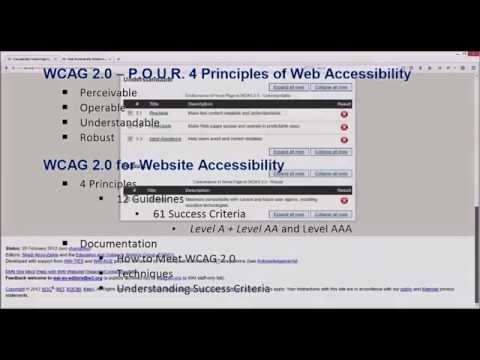3.1: Introduction to WCAG
- Page ID
- 15502
 Now that Lulu has a better understanding of what a web accessibility audit entails and has decided with certainty to move forward with one, she is seeking a recommended resource that might allow her webmaster to familiarize herself more thoroughly with the features of accessible web content. Without a doubt, WCAG 2.0 is the resource that she is looking for. Review the content below to understand the significance and purpose of this critical element of Lulu’s, and your, toolkit.
Now that Lulu has a better understanding of what a web accessibility audit entails and has decided with certainty to move forward with one, she is seeking a recommended resource that might allow her webmaster to familiarize herself more thoroughly with the features of accessible web content. Without a doubt, WCAG 2.0 is the resource that she is looking for. Review the content below to understand the significance and purpose of this critical element of Lulu’s, and your, toolkit.Though it is possible to conduct informal accessibility reviews with basic understanding of the types of barriers faced by people with disabilities, and knowledge of the common elements in web content that often produce barriers, a thorough, professional review requires a solid understanding of the W3C Web Content Accessibility Guidelines (WCAG 2.0 or WCAG 2.1, aka ISO/IEC 40500:2012).
This unit will introduce you to WCAG (pronounced “wuh-kag”), which provides the basis for most international accessibility rules and legislation, along with its supporting documents. WCAG should be a key element of your Web Accessibility Auditing Toolkit. You should develop a basic understanding of WCAG to start, then use it and its supporting documents as references while conducting your audits and build upon the basics as you go about auditing web content.
Watch the following video for a brief overview of WCAG 2.0.
Video: WCAG-WAI Basics
© Richard Fouchaux. Released under the terms of a Creative Commons Attribution license.
Documents Accompanying WCAG
Accompanying the WCAG specification itself are a variety of documents that expand on the guidelines. The two types of documents we would like to draw your attention to are:
- Understanding Guidelines
- How to Meet WCAG (referred to as Success Criteria)
These documents are conveniently linked next to their corresponding guideline, as shown in the figure below.

Figure: Links to supporting documents appear next to each guideline in WCAG 2.0
10 Key Guidelines
Required Reading: The 10 Key Guidelines of WCAG 2.0/2.1 have been summarized in a downloadable PDF document.
Download the 10 Key Guidelines [PDF] document, and read through it to familiarize yourself with the manner in which WCAG 2.0/2.1 addresses the most common accessibility issues.



